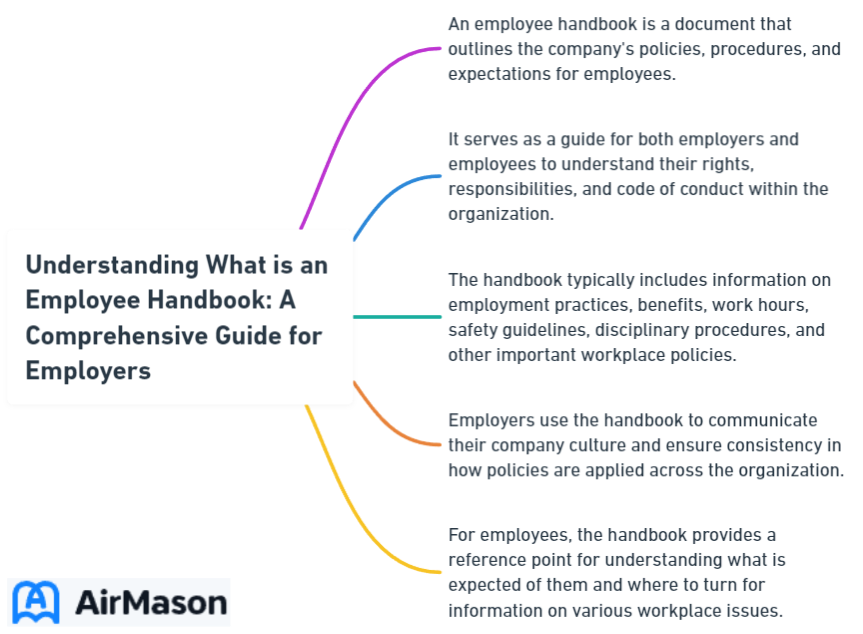
What is an employee handbook? It’s an essential document that functions as the nexus between a company and its employees, detailing policies, procedures, and the corporate ethos. Beyond providing a clear framework for expectations and conduct, it addresses the legalities surrounding employment within the company and safeguards against misunderstandings. Through the following sections, we will unpack the creation, utilization, and significance of an employee handbook, ensuring you comprehend its role as the cornerstone of an informed and compliant workplace.
Key Takeaways
- An employee handbook is a critical document that outlines a company’s mission, values, policies, procedures, and benefits, providing clarity on roles, expectations, and legal compliance for employees.
- Key elements within a successful employee handbook include sections on company culture, values, employment policies, compensation, benefits, and procedures for time off, all of which help guide and protect both employees and employers.
- A well-crafted employee handbook requires an engaging and accessible writing style, regular legal reviews and updates, and must include nondiscrimination policies as well as at-will employment terms, all reinforced through employee acknowledgment during onboarding.
Employee Handbook Distribution
Employee Handbook Distribution is a crucial aspect of ensuring that all employees have access to vital company policies and procedures. This process involves disseminating the handbook to every employee upon hiring and ensuring that updates are promptly provided as policies evolve. A well-distributed handbook sets clear expectations for behavior, performance, and company culture, fostering a cohesive work environment. Utilizing digital platforms for distribution can streamline the process and ensure easy access for remote or dispersed teams. Additionally, implementing acknowledgment forms or quizzes can verify that employees have reviewed the handbook, promoting accountability and understanding. Consistent and thorough distribution of the employee handbook is essential for maintaining compliance, fostering a positive workplace culture, and mitigating potential legal risks.
Defining an Employee Handbook
Often called an employee manual or staff handbook, an employee handbook is not merely a collection of company policies. It is a comprehensive guide that outlines the company’s:
- mission
- values
- policies
- procedures
- benefits
This essential document acts as a bridge between HR leadership and employees, communicating the company’s mission, vision, and purpose beyond mere policy and compliance.
It provides an overview of the organization’s policies, setting clear expectations for employees and informing them of their rights.

The Role of an Employee Handbook in a Company
An employee handbook serves as a reliable reference guide for both employees and management, outlining expectations and responsibilities. Employee handbooks help eliminate confusion and inconsistencies by clearly communicating company policies. Such transparency promotes harmony between managers and staff, simplifies operations, and reduces disputes.
The handbook assists employers in effective business management by:
- Clarifying employees’ roles and expectations
- Setting the stage for a harmonious employment relationship
- Fostering a positive work environment where everyone knows what is expected of them.
Legal Significance of an Employee Handbook
Not only does an employee handbook serve practical purposes, but it also carries significant legal weight. A well-crafted handbook helps organizations adhere to federal and state laws and serves as a protective shield against potential lawsuits. It ensures that the company meets legal information requirements by informing employees of their rights and organizational policies.
However, creating a legally sound handbook involves careful attention to language. For instance, the language used should prevent accidental modification of the at-will employment relationship or creation of implied contracts through statements regarding job security or discipline policies. A well-constructed employee handbook thus serves as evidence of ‘reasonable care’ by the employer and is crucial for defensibility in legal claims.
Key Components of an Effective Employee Handbook

With a clear understanding of what an employee handbook is and its purpose, we can now explore the key elements that make it effective. A comprehensive employee handbook should include sections on company culture and values, employment policies and procedures, and details on compensation, benefits, and time off.
Let’s further explore these elements.
Company Culture and Values
The employee handbook serves as a cultural compass, introducing new employees to the company’s culture, mission, and values. These insights enable employees to grasp their pivotal role in the organization and their fit within the company’s culture, thereby strengthening their bond with the company.
The handbook also guides employees on:
- Engaging with company values and communication etiquette
- Motivating them to actively participate in the company’s community and culture initiatives
- Outlining Diversity, Equity, and Inclusion (DEI) efforts, reflecting the company’s commitment to fostering an inclusive and diverse work environment
This not only benefits morale, but also drives productivity and innovation.
Employment Policies and Procedures
The employee handbook provides employees with a guide for acceptable conduct and fairness in the workplace. It outlines company policies, serving as a resource for checking policies on dress codes, vacation, and remote work expectations. The handbook’s solid framework clarifies for employees what the company expects from them.
In today’s evolving work environment, the inclusion of COVID-19 policies and remote work guidelines has become essential. This ensures clarity on the company’s pandemic response and remote work requirements. Furthermore, by outlining policies on harassment and discrimination, handbooks help mitigate legal risks and provide reporting and grievance procedures. The handbook should also address the appropriate use of company equipment like laptops and cell phones and outline communication guidelines.
Compensation, Benefits, and Time Off
The employee handbook should comprehensively cover the company’s compensation, benefits, and leave policies. It should detail the payroll process, including deductions and payroll dates, and clarify overtime compensation, especially for non-exempt employees.
The handbook must also define companywide working hours, the specific number of paid days off, and the procedure for requesting leave, alongside policies for:
- sick leave
- bereavement leave
- leave for civic duties such as jury duty and voting
- parental leave mandates and processes involved
Information on the health and safety policy should be provided in the handbook.
The handbook should clearly outline all benefits available to employees, including healthcare, retirement, and disability coverage, along with explanations of relevant laws and any additional perks like company car usage policies.
What Should Be Included in an Employee Handbook
When creating an employee handbook, it’s essential to know what should be included in an employee handbook and cover key policies, procedures, and expectations to ensure clarity and consistency across the organization. This document typically includes information on company mission and values, code of conduct, employee benefits, leave policies, disciplinary procedures, and other important HR policies. Additionally, it should outline employee rights, responsibilities, and procedures for addressing grievances or conflicts. By providing comprehensive information in the employee handbook, organizations can promote transparency, compliance, and a positive work environment for all employees.
Crafting an Engaging and Informative Employee Handbook

Creating a captivating and informative employee handbook requires a balance between being clear and comprehensive. The handbook should be written in an engaging and straightforward language to ensure that even complex policies are understood by all employees, making the handbook more effective.
Writing Style and Tone
The effectiveness of the employee handbook depends largely on its writing style and tone. A conversational tone and clear language help prevent feelings of alienation, fostering trust and engagement with the handbook. Using plain language and expressing policies straightforwardly ensures that employees at all levels can understand and adhere to the company policies.
Specific language and relevant examples within policies provide clear guidance and eliminate ambiguity, making the handbook more effective. Active voice makes instructions more direct and easier for employees to follow.
Accessibility and Distribution
Making the employee handbook accessible is just as important as creating it effectively. Making the handbook available on the company’s intranet allows all employees within their self-domain to access it while maintaining privacy and security.
Providing alternative formats of the handbook accommodates employees with different disabilities or impairments. The handbook can be shared with employees through:
- Printed copies at new hire orientations
- Annual company training
- Email for remote workers
- Company intranet or shared drive
Alternative formats can include audio, video, or braille versions of the handbook.
A well-organized handbook with clear headings and subheadings enhances clarity and eases navigation, aiding employees in finding the information they need.
Regular Updates and Reviews
Similar to other vital organizational documents, it’s important to regularly review and update the employee handbook. This ensures it reflects the current state of the company and complies with applicable laws.
The employee handbook should be reviewed at least once a year, or more frequently if the company experiences significant changes. HR should consistently monitor the handbook throughout the year, noting any required revisions such as changes in policy relevance, new additions, and error corrections. When changes are made, employees should be notified, provided with clear instructions on how to stay informed about policy updates, and be required to acknowledge their responsibility to stay informed of such changes.
Employee Handbook Compliance and Legal Considerations

Considering legal aspects while creating an employee handbook is of paramount importance. Consulting a lawyer for the review of an employee handbook ensures legal compliance and can prevent potential legal claims by reflecting current employment laws and regulations accurately.
Anti-Harassment and Non-Discrimination Policies
Compliance with anti-harassment and non-discrimination policies is a fundamental part of any employee handbook. These policies must comply with various levels of laws, including Title VII of the Civil Rights Act of 1964, which prohibits discrimination on the basis of race, color, religion, sex, and national origin, and helps address unfair treatment claims.
A nondiscrimination policy should outline the company’s stance against discrimination or harassment due to:
- age
- race
- religion
- pregnancy
- disability
- other characteristics protected by law
The company policy should forge a workplace atmosphere where all individuals are regarded with respect and dignity, fostering an environment free of bias, prejudice, and harassment.
It is critical for the policy to detail the following:
- Retaliation is strictly prohibited against anyone reporting or participating in an investigation of discrimination or harassment.
- Potential disciplinary measures for violations of the policy, as part of the disciplinary and grievance procedures.
- Provisions to handle false and malicious complaints.
Employment Relationship and At-Will Employment
The employee handbook should offer clear definitions of the employment relationship and the concept of at-will employment. At-will employment allows an employer to terminate an employee for any reason, except for illegal reasons, and an employee can also quit for any or no reason, barring exceptions like discrimination or retaliation.
The at-will employment relationship should be explicitly reaffirmed in employee acknowledgment forms, highlighting its non-contractual nature, unless overridden by specific legal or contractual conditions, such as an employment agreement. Both the employer and employee should be aware that written or oral contracts that promise job security can negate the conditions of at-will employment by stipulating specific terms or durations of employment that must be met before termination is permissible.
Employee handbook acknowledgment forms are a best practice to clarify that the handbook is a guide to company policies, not an employment contract, which normally preserves the at-will status. New hire and separation policies lay down essential employment terms including:
- at-will employment conditions
- eligibility for benefits
- pay periods
- rules regarding transfers and referrals within the company.
Onboarding and Employee Acknowledgment

Incorporating the employee handbook into the induction process and securing employee acknowledgment is key to effective management of the handbook.
Presenting the employee handbook during onboarding enables new employees to rapidly comprehend their rights, responsibilities, and benefits.
Integrating the Employee Handbook into Onboarding
The employee handbook serves as a welcome mat for new employees, providing them with all the essential information to acclimate to the new work environment. Including company culture and values in the employee handbook assists with the integration of new employees by familiarizing them with the organization’s:
- culture
- mission
- vision
- values
The handbook also offers insights into the company’s operational protocols and communicates job roles and expectations, as well as introducing new employees to the organizational structure. Incorporating the handbook into onboarding encourages open dialogue and learning about all aspects of the handbook, and acknowledgment by new hires confirms their understanding of company policies and procedures.
Employee Acknowledgment and Documentation
Securing employee acknowledgment and documentation is a crucial step in the handbook distribution process. An acknowledgment of receipt section is essential for ensuring that employees confirm they have received and understood the employee handbook.
Once signed, the acknowledgment form should be properly filed in the employee’s personnel file for future reference. The signed form should verify that the employee is aware of and agrees to their responsibility to read and comply with the policies in the handbook.
When handbooks are updated, employees should be provided with the new version, highlights of any changes, and secure a fresh acknowledgment of receipt and understanding. Employees are made aware of the consequences for violating company policies through the acknowledgment form they sign upon receipt of the handbook.
Kentucky Employee Handbook
The Kentucky Employee Handbook serves as a comprehensive guide for employees outlining company policies, procedures, and expectations. It provides valuable information on topics such as employment eligibility, benefits, code of conduct, and grievance procedures. Employees in Kentucky can refer to the handbook for clarity on their rights and responsibilities within the organization. Additionally, the handbook serves as a reference tool for managers and HR professionals to ensure consistency and compliance across the workforce. Keeping the Kentucky Employee Handbook updated and accessible is essential for fostering a positive work environment and promoting transparency and fairness within the workplace.
Summary
In summary, an employee handbook is an indispensable tool for an organization, serving as a comprehensive guide for employees and a communication tool for employers. It sets clear expectations, eliminates confusion, ensures compliance with laws, and fosters a strong organizational identity. Crafting an engaging and informative handbook requires a clear writing style, accessibility, and regular updates. With the right approach, an employee handbook can significantly enhance the employee experience and contribute to the organization’s success.
Frequently Asked Questions
What is the purpose of an employee handbook?
The purpose of an employee handbook is to establish and communicate the company’s culture, mission, vision, and values in a way that employees can easily understand and connect with them. This helps to set clear expectations and guidelines for employees.
Is an employee handbook a legal document?
An employee handbook is typically not considered a legally binding document, unless it explicitly states that it is. However, specific statements within the handbook may be seen as contractual promises under certain circumstances.
What is the difference between an employee handbook and a policy?
An employee handbook is designed for employees to understand expectations and find answers, while a policy manual is for company leaders and managers to oversee policies.
What’s another name for an employee handbook?
An employee handbook can also be referred to as an Employee Guide, Manual, Policy Guide, or Playbook. These are alternative names for the same essential resource.
How should an employee handbook be written?
An employee handbook should be written in a clear, engaging, and specific style that is easily understood by all employees. It should avoid complicated language and jargon to ensure clarity and accessibility.
Important Disclaimer:
Please be aware that the content on this page has been generated by using artificial intelligence language models and may contain errors, inconsistencies, or outdated information. It is provided as-is without any warranties or guarantees of accuracy.
We strongly recommend using this content as a starting point for further research. We disclaim any liability for damages or losses resulting from the use or reliance on this content.